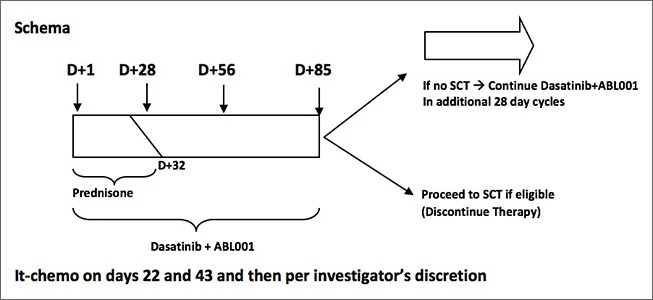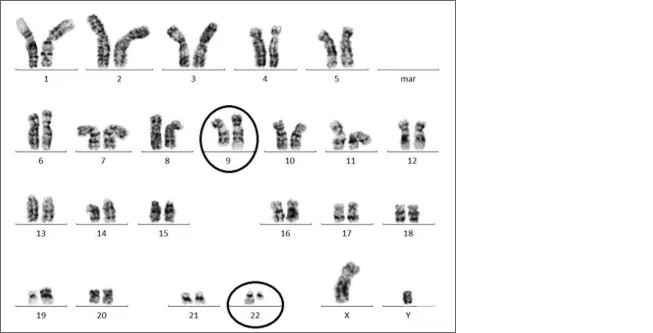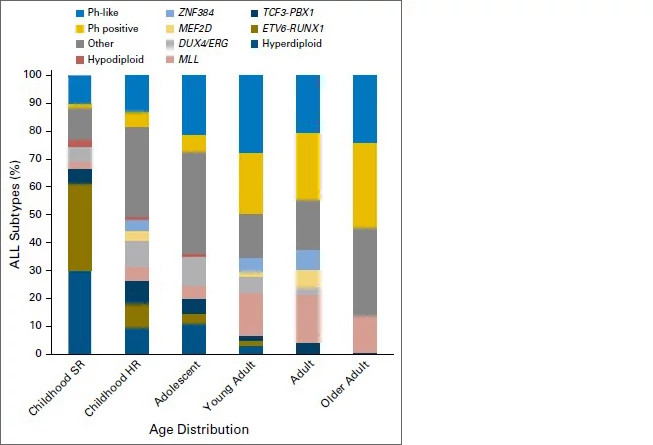BCR-ABL (Philadelphia-chromosome) positive (BCR-ABL+) acute lymphoblastic leukemia (ALL) is the most common genetic subtype of ALL in adults and historically has been associated with a poor prognosis. The incorporation of ABL tyrosine kinase inhibitors (TKIs) into ALL chemotherapy regimens has dramatically improved outcomes for patients with BCR-ABL+ALL. However, relapses remain common, particularly in those patients who are ineligible for intensive chemotherapy and allogeneic HSCT.
Most relapses in BCR-ABL+ ALL are associated with resistance mutations in ABL that inhibit drug binding, suggesting that blast cells in patients who relapse after TKI treatment remain addicted to ABL kinase activity. Asciminib (ABL001) is a potent, specific allosteric inhibitor of ABL being developed by Novartis that binds to a site spatially distinct from the catalytic domain targeted by traditional TKIs. Asciminib has established efficacy against BCR-ABL mutations conferring resistance to those standard TKIs. Therefore, we hypothesized that targeting BCR-ABL+ ALL with dual ABL blockade by administering both a traditional ABL kinase catalytic domain inhibitor (dasatinib) and the allosteric inhibitor (asciminib) would improve depth and durability of remissions in this disease. This approach is supported by pre-clinical animal models of BCR-ABL+ leukemia, which have shown that combined ABL inhibition prolongs survival compared to single agent therapy.
Our Dana-Farber investigator-initiated phase 1 study (NCT03595917) of asciminib in combination with dasatinib plus prednisone in BCR-ABL+ ALL and chronic myeloid leukemia (CML) in lymphoid blast crisis is underway. This study uses a 3+3 dose escalation design with an expansion cohort, with the primary objective to determine the maximal tolerated dose (MTD) or recommended phase 2 dose (RP2D), with secondary objectives that include characterizing the depth and durability of responses. Patients over 50 years old with newly diagnosed BCR-ABL+ ALL or CML in blast phase are eligible, along with patients with disease relapsed to prior therapy but with no prior exposure to dasatinib or asciminib and no known T315I mutation. Patients are treated continuously with an all oral regimen of dasatinib, asciminib, and prednisone (tapered after one month). Correlative science that is being conducted by Dana-Farber laboratory-based investigators aims to identify biomarkers of response to combined BCR-ABL blockade and molecular signatures enriched in minimal residual disease (MRD), based on targeted tumor sequencing and serial single-cell RNA sequencing of leukemia and stromal populations from blood and bone marrow.
Preliminary results were presented at the ASH Annual Meeting in Orlando, Florida, in December 2019 (doi.org/10.1182/blood-2019-125138). We reported that applying dual ABL1 kinase inhibition with asciminib and dasatinib plus prednisone in newly diagnosed BCR-ABL1+ ALL is feasible in older adults with no increase in toxicity compared to currently used TKI + corticosteroid regimens. The trial is ongoing at Dana-Farber/Harvard Cancer Center.



